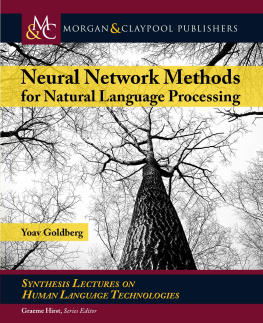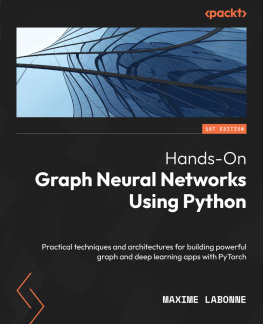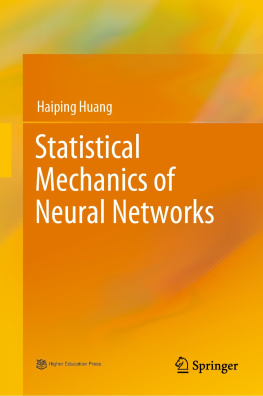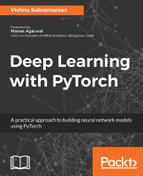Neural Network Methods for
Natural Language Processing
Synthesis Lectures on Human Language Technologies
Editor
Graeme Hirst, University of Toronto
Synthesis Lectures on Human Language Technologies is edited by Graeme Hirst of the University of Toronto. The series consists of 50- to 150-page monographs on topics relating to natural language processing, computational linguistics, information retrieval, and spoken language understanding. Emphasis is on important new techniques, on new applications, and on topics that combine two or more HLT subfields.
Neural Network Methods for Natural Language Processing
Yoav Goldberg
2017
Syntax-based Statistical Machine Translation
Philip Williams, Rico Sennrich, Matt Post, and Philipp Koehn
2016
Domain-Sensitive Temporal Tagging
Jannik Strtgen and Michael Gertz
2016
Linked Lexical Knowledge Bases: Foundations and Applications
Iryna Gurevych, Judith Eckle-Kohler, and Michael Matuschek
2016
Bayesian Analysis in Natural Language Processing
Shay Cohen
2016
Metaphor: A Computational Perspective
Tony Veale, Ekaterina Shutova, and Beata Beigman Klebanov
2016
Grammatical Inference for Computational Linguistics
Jeffrey Heinz, Colin de la Higuera, and Menno van Zaanen
2015
Automatic Detection of Verbal Deception
Eileen Fitzpatrick, Joan Bachenko, and Tommaso Fornaciari
2015
Natural Language Processing for Social Media
Atefeh Farzindar and Diana Inkpen
2015
Semantic Similarity from Natural Language and Ontology Analysis
Sbastien Harispe, Sylvie Ranwez, Stefan Janaqi, and Jacky Montmain
2015
Learning to Rank for Information Retrieval and Natural Language Processing, Second Edition
Hang Li
2014
Ontology-Based Interpretation of Natural Language
Philipp Cimiano, Christina Unger, and John McCrae
2014
Automated Grammatical Error Detection for Language Learners, Second Edition
Claudia Leacock, Martin Chodorow, Michael Gamon, and Joel Tetreault
2014
Web Corpus Construction
Roland Schfer and Felix Bildhauer
2013
Recognizing Textual Entailment: Models and Applications
Ido Dagan, Dan Roth, Mark Sammons, and Fabio Massimo Zanzotto
2013
Linguistic Fundamentals for Natural Language Processing: 100 Essentials from Morphology and Syntax
Emily M. Bender
2013
Semi-Supervised Learning and Domain Adaptation in Natural Language Processing
Anders Sgaard
2013
Semantic Relations Between Nominals
Vivi Nastase, Preslav Nakov, Diarmuid Saghdha, and Stan Szpakowicz
2013
Computational Modeling of Narrative
Inderjeet Mani
2012
Natural Language Processing for Historical Texts
Michael Piotrowski
2012
Sentiment Analysis and Opinion Mining
Bing Liu
2012
Discourse Processing
Manfred Stede
2011
Bitext Alignment
Jrg Tiedemann
2011
Linguistic Structure Prediction
Noah A. Smith
2011
Learning to Rank for Information Retrieval and Natural Language Processing
Hang Li
2011
Computational Modeling of Human Language Acquisition
Afra Alishahi
2010
Introduction to Arabic Natural Language Processing
Nizar Y. Habash
2010
Cross-Language Information Retrieval
Jian-Yun Nie
2010
Automated Grammatical Error Detection for Language Learners
Claudia Leacock, Martin Chodorow, Michael Gamon, and Joel Tetreault
2010
Data-Intensive Text Processing with MapReduce
Jimmy Lin and Chris Dyer
2010
Semantic Role Labeling
Martha Palmer, Daniel Gildea, and Nianwen Xue
2010
Spoken Dialogue Systems
Kristiina Jokinen and Michael McTear
2009
Introduction to Chinese Natural Language Processing
Kam-Fai Wong, Wenjie Li, Ruifeng Xu, and Zheng-sheng Zhang
2009
Introduction to Linguistic Annotation and Text Analytics
Graham Wilcock
2009
Dependency Parsing
Sandra Kbler, Ryan McDonald, and Joakim Nivre
2009
Statistical Language Models for Information Retrieval
ChengXiang Zhai
2008
Copyright 2017 by Morgan & Claypool
All rights reserved. No part of this publication may be reproduced, stored in a retrieval system, or transmitted in any form or by any meanselectronic, mechanical, photocopy, recording, or any other except for brief quotations in printed reviews, without the prior permission of the publisher.
Neural Network Methods for Natural Language Processing
Yoav Goldberg
www.morganclaypool.com
ISBN: 9781627052986 | paperback |
ISBN: 9781627052955 | ebook |
DOI 10.2200/S00762ED1V01Y201703HLT037
A Publication in the Morgan & Claypool Publishers series
SYNTHESIS LECTURES ON HUMAN LANGUAGE TECHNOLOGIES
Lecture #37
Series Editor: Graeme Hirst, University of Toronto
Series ISSN
Print 1947-4040 Electronic 1947-4059
Neural Network Methods for
Natural Language Processing
Yoav Goldberg
Bar Ilan University
SYNTHESIS LECTURES ON HUMAN LANGUAGE TECHNOLOGIES #37

ABSTRACT
Neural networks are a family of powerful machine learning models. This book focuses on the application of neural network models to natural language data. The first half of the book () covers the basics of supervised machine learning and feed-forward neural networks, the basics of working with machine learning over language data, and the use of vector-based rather than symbolic representations for words. It also covers the computation-graph abstraction, which allows to easily define and train arbitrary neural networks, and is the basis behind the design of contemporary neural network software libraries.
The second part of the book () introduces more specialized neural network architectures, including 1D convolutional neural networks, recurrent neural networks, conditioned-generation models, and attention-based models. These architectures and techniques are the driving force behind state-of-the-art algorithms for machine translation, syntactic parsing, and many other applications. Finally, we also discuss tree-shaped networks, structured prediction, and the prospects of multi-task learning.
KEYWORDS
natural language processing, machine learning, supervised learning, deep learning, neural networks, word embeddings, recurrent neural networks, sequence to sequence models
Contents
Preface
Natural language processing (NLP) is a collective term referring to automatic computational processing of human languages. This includes both algorithms that take human-produced text as input, and algorithms that produce natural looking text as outputs. The need for such algorithms is ever increasing: human produce ever increasing amounts of text each year, and expect computer interfaces to communicate with them in their own language. Natural language processing is also very challenging, as human language is inherently ambiguous, ever changing, and not well defined.
Natural language is symbolic in nature, and the first attempts at processing language were symbolic: based on logic, rules, and ontologies. However, natural language is also highly ambiguous and highly variable, calling for a more statistical algorithmic approach. Indeed, the current-day dominant approaches to language processing are all based on
Next page






